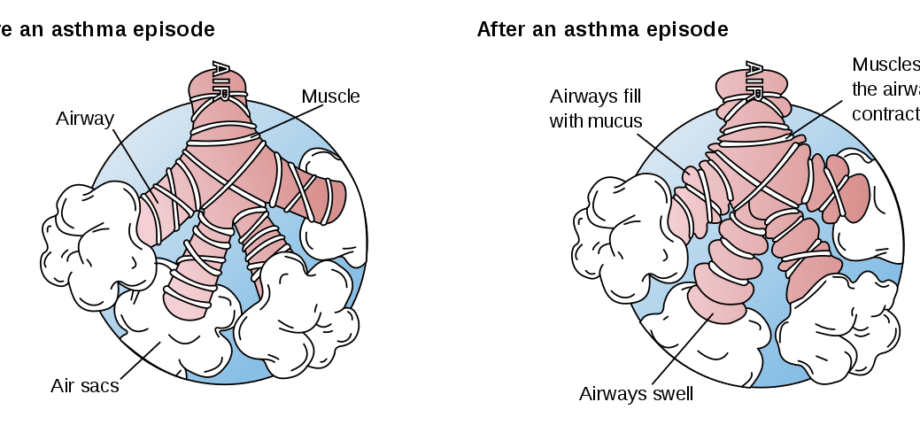Contents
Bronchospasm
Bronchospasm is a contraction of the lungs that causes temporary obstruction of the airways, common in people with asthma. This causes a drastic drop in respiratory capacity, for a relatively short time but very badly experienced by the patients.
Bronchospasm, pulmonary contraction
What is a bronchospasm?
Bronchospasm refers to the contraction of muscles on the wall of the bronchi, the respiratory network at the heart of our lungs.
This contraction is one of the main consequences of asthma: a very common disease of the respiratory tract. The airways of people with asthma are very often inflamed and covered with mucus, which reduces the space available for air circulation. This reduction is permanent and reduces the respiratory capacity of asthma patients.
Bronchospasm is a one-off phenomenon. It occurs when the muscles of the bronchi contract.
By analogy, we can imagine that our lungs are like trees, with a common trunk (where air arrives), and multiple branches, the bronchi. Asthmatics have branches that are stuck inside, because of their inflammation and swelling. And during a bronchospasm, these bronchi contract as a result of the action of the muscles around them. By contracting, the bronchi therefore reduce the available respiratory flow even more, in the same way as when a tap is switched from its maximum flow to a reduced flow, or even cut off.
It is estimated that about 15% of asthmatics perceive their bronchospasms little, out of habit of having their respiratory flows obstructed.
How to recognize it?
The bronchospasm is felt by the patient when his exhalation is difficult, as if obstructed. The exhaled air may make a slight hissing sound or even cause coughing.
Risk factors
Bronchospasm is inherently dangerous, since it affects one of the most essential survival needs: breathing. The contraction of the bronchi in a way “closes” all the respiratory tracts, which suffocates the suffering person for an instant.
The risks associated with bronchospasm are therefore those depending on the situation. Bronchospasm can occur in delicate situations: sport, anesthesia, sleep, and have dramatic consequences.
What causes bronchospasm
Asthma
Bronchospasm is one of the two hallmarks of asthma, along with inflammation of the airways. Asthma is a vicious circle for those who have it: the airways are reduced, which generates the creation of mucus which further obstructs the room for oxygen.
Chronic bronchitis (COPD)
Disease that mostly affects regular smokers, but it can also be attributed to pollution, dust or a humid climate. It is distinguished by a strong cough, and causes shortness of breath.
Emphysema
Pulmonary emphysema is a chronic disease of the lungs. If the causes are the same as those of chronic bronchitis (pollution, tobacco), it is characterized by irritation of the alveoli, the small air pockets in the lungs, leading to breathing difficulties.
Bronchiectasis
Bronchiectasis are rare diseases, causing excessive dilation of the bronchi and causing violent coughs, and sometimes bronchospasms.
Risks in case of complications
Bronchospasm is a violent contraction, so its complications will be closely related to the patient’s condition at the time of these contractions. It can lead to severe respiratory failure, which will have different impacts on the body:
- Fainting, coma
- Panic attack
- Trembling, sweating
- Hypoxia (insufficient oxygen supply)
- Heart failure, heart failure
The main risk remains bronchospasm during anesthesia, as the body is subjected to anesthetics which can cause respiratory arrest if coupled with bronchospasm.
Treat and prevent bronchospasm
Bronchospasms are by nature one-off phenomena. To prevent their occurrence, one can use drugs capable of improving the respiratory tract.
Analyze the lungs
First and foremost, the patient’s breathing capacities should be analyzed using spirometric devices, which assess the patient’s breathing capacities.
Inhalation the bronchodilators
Bronchospasm is treated with bronchodilators, which are inhaled drugs. Those if will attach themselves to the muscles surrounding the bronchi to relax them. The pressure exerted is therefore reduced, which makes it possible to avoid violent bronchospasms, but also to reduce the appearance of mucus in the bronchi.
The most widely used bronchodilators are anticholinergics and other beta2 adrenergic receptor stimulants.
Bronchotomy / Tracheotomy
In more serious cases, we can treat too frequent bronchospasm by performing a tracheotomy (or bronchotomy), the forced and surgical opening of a bronchus.










